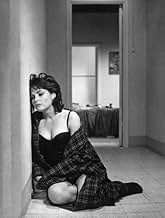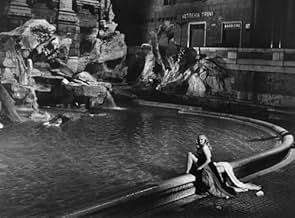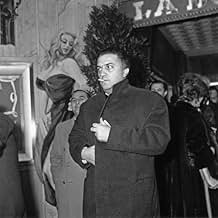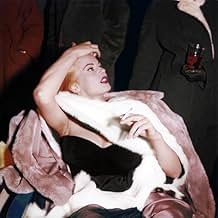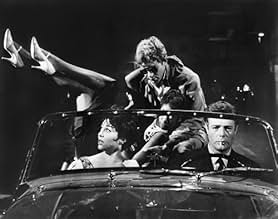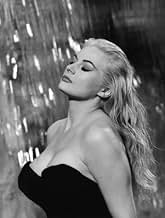La dolce vita
- 1960
- Tous publics
- 2h 54m
A series of stories following a week in the life of a philandering tabloid journalist living in Rome.A series of stories following a week in the life of a philandering tabloid journalist living in Rome.A series of stories following a week in the life of a philandering tabloid journalist living in Rome.
- Won 1 Oscar
- 11 wins & 12 nominations total
Anouk Aimée
- Maddalena
- (as Anouk Aimee)
Magali Noël
- Fanny
- (as Magali Noel)
Summary
Reviewers say 'La Dolce Vita' features American actors portraying real-life celebrities and industry figures, though their exact identities remain unconfirmed. The film delves into themes of fame, decadence, and the superficiality of celebrity culture, using these characters to underscore the contrasts and contradictions within high society. The portrayal of these characters enhances the film's satirical and critical perspective on the lifestyles and attitudes of the era, offering a nuanced commentary on the nature of fame and its impact on individuals and society.
Featured reviews
(first of all, sorry my poor english) Who, in this entire world, drunk as a horse in the middle of the night, never discovered the meaning of life, that it can be so easy and joyfull that hurts. This happens with a certain frequency. The big problem is, after all that, to face all the thoughts and conclusions in a sober monday morning, when everything is just real, concious and above all that sincere. This is the the big question and problem of Marcello Rubini, a reporter of a gossip magazines who has to deal with the fact that he tastes the same poison he spreads by leaving in a group of people which he sucks his living.
In a moment he is directing his papparazzi and, in the next, he is running away from them. He flows between all kinds of social circles and the only impression he gives is that it doesnt matter what kind of craziness you are getting into everything is a big cliché. From the mainstream world of a gorgeous actress who feels able to express opinions about everything (and we buy it), passing throught the religious world of the faith, and also an intellectual circle that gives a fake impression of freedom, everything turns out to be an escape. That blonde girl appears as a stroke of pureness and sincereness, something we should really look for, but we just dont. In the case of Marcello's life, writing is the solutions he always substitute for vain experiences. Something he likes and that he needs a young girl to tell him that. That litlle cute girl is a person Marcello would like to be, someone who faces the soberty of a monday morning with hopeness and happiness.
A masterpiece.
In a moment he is directing his papparazzi and, in the next, he is running away from them. He flows between all kinds of social circles and the only impression he gives is that it doesnt matter what kind of craziness you are getting into everything is a big cliché. From the mainstream world of a gorgeous actress who feels able to express opinions about everything (and we buy it), passing throught the religious world of the faith, and also an intellectual circle that gives a fake impression of freedom, everything turns out to be an escape. That blonde girl appears as a stroke of pureness and sincereness, something we should really look for, but we just dont. In the case of Marcello's life, writing is the solutions he always substitute for vain experiences. Something he likes and that he needs a young girl to tell him that. That litlle cute girl is a person Marcello would like to be, someone who faces the soberty of a monday morning with hopeness and happiness.
A masterpiece.
Long, episodic film by Federico Fellini about the conceits and facades of life: fame, intellect, sex, friendship, despair, innocence, etc.
Marcello Mastroianni is perfect as the shallow tabloid reporter who joyfully follows around Rome a blonde movie star from Sweden (Anita Ekberg) as she prowls around the city's bars and bistros. He is also having an affair with a woman (Anouk Aimee) while his girl friend (Yvonne Furnaux) seems to be going nuts.
But as Marcello moves through the city following the movie star, the miracle of the virgin, a few parties, etc. we see that his life is very empty because the things he reports on are meaningless drivel. We see that fame and fortune and the trappings of success are meaningless.
Marcello starts to realize that the movie star is a vapid airhead, the miracles are a sham, and his friend's (who seemed quite happily married) ghastly murder and suicide show the futility of life itself.
The Fellini themes are common to many of his films, but what makes La Dolce Vita so memorable are the cynical tone, the Nina Rota music, and the string of terrific visual images.
The opening scene is of a helicopter hauling a gilded plaster statue through the air across Rome. The flying saint is a bizarre image but serves to set up the movies which is all about images and events that are never what they seem to be.
Notable are the scenes of statuesque Ekberg in that terrific strapless black dress with the voluminous skirts as she swishes around dancing and eventually wading through a city fountain. The party scenes are also notable. The first because of the intolerable intellectuals who sits around and talk and talk but never do anything. The last party has the indelible image of Mastroianni "riding" a drunken blonde woman as though she were a horse. The final image of the giant dead fish is quite unsettling as it symbolizes their bloated lives.
Fellini is brilliant in filling scenes with odd people as extras, usually hideously dressed or wearing ugly glasses. The "gallery" of people who inhabit the city is one of grotesques, vapid fashion slaves, the rich, hangers on, etc.
A long film, but highly recommended and very memorable.
Marcello Mastroianni is perfect as the shallow tabloid reporter who joyfully follows around Rome a blonde movie star from Sweden (Anita Ekberg) as she prowls around the city's bars and bistros. He is also having an affair with a woman (Anouk Aimee) while his girl friend (Yvonne Furnaux) seems to be going nuts.
But as Marcello moves through the city following the movie star, the miracle of the virgin, a few parties, etc. we see that his life is very empty because the things he reports on are meaningless drivel. We see that fame and fortune and the trappings of success are meaningless.
Marcello starts to realize that the movie star is a vapid airhead, the miracles are a sham, and his friend's (who seemed quite happily married) ghastly murder and suicide show the futility of life itself.
The Fellini themes are common to many of his films, but what makes La Dolce Vita so memorable are the cynical tone, the Nina Rota music, and the string of terrific visual images.
The opening scene is of a helicopter hauling a gilded plaster statue through the air across Rome. The flying saint is a bizarre image but serves to set up the movies which is all about images and events that are never what they seem to be.
Notable are the scenes of statuesque Ekberg in that terrific strapless black dress with the voluminous skirts as she swishes around dancing and eventually wading through a city fountain. The party scenes are also notable. The first because of the intolerable intellectuals who sits around and talk and talk but never do anything. The last party has the indelible image of Mastroianni "riding" a drunken blonde woman as though she were a horse. The final image of the giant dead fish is quite unsettling as it symbolizes their bloated lives.
Fellini is brilliant in filling scenes with odd people as extras, usually hideously dressed or wearing ugly glasses. The "gallery" of people who inhabit the city is one of grotesques, vapid fashion slaves, the rich, hangers on, etc.
A long film, but highly recommended and very memorable.
Marcello Rubini (Marcello Mastroianni) is a man-about-town and a gossip journalist in Rome. His girlfriend Emma overdoses and recovers. Swedish-American bombshell Sylvia (Anita Ekberg) arrives and hangs out with Marcello while the Paparazzo hounds them. Her boyfriend Robert gets angry and hits him. As his series of adventures continue, there is an emptiness to it all and a meaninglessness to his life.
This iconic film has a disjointed narrative structure. It has many sections without the connective tissue. It's a tough watch especially for a three hour movie. It's exhilarating for a long time but it gets tiring by the end. The sad emptiness infects the viewing experience. The lifestyle is thoroughly modern celebrity world. The thrill disapates. Its iconic nature deserves extra points, but this is strictly for film fans.
This iconic film has a disjointed narrative structure. It has many sections without the connective tissue. It's a tough watch especially for a three hour movie. It's exhilarating for a long time but it gets tiring by the end. The sad emptiness infects the viewing experience. The lifestyle is thoroughly modern celebrity world. The thrill disapates. Its iconic nature deserves extra points, but this is strictly for film fans.
When it comes to art, the best one can do is receive it with grace, measure it against one's soul and if one is so inclined, speak from the heart about it. That's the only thing that matters, all else falling away. Comments about the execution are irrelevant, really. If someone talks about that, it isn't from their heart and doesn't really matter. This is excellently executed, but with art the only demand is that it cross a threshold of competence, making it close enough for us to reach. All else is decoration. Read elsewhere for comments on the decorative qualities of this.
I'll start from the end. I recommend you see this because it is a necessary launching ramp for "8 1/2." I believe that film is essential viewing for any citizen of the world, and to get it, you have to sit through this. Its roughly the same shape: Fellini himself, an empty and artless man posing as an artist who can only place himself in a definition of emptiness defined by the seven types of women.
In this world a convincing one women define the world by their being, and all spaces physical spaces I mean are carried by them into existence. Men merely stand between surrounding walls and the woman who made them whether she is present or not. When strained through the cloth of cinema, we have something like this film. (I wish some Japanese filmmaker would do for this what "H Story" did to "Hiroshima Mon Amore" but in Barcelona.)
So it is a competent film, even decorative. It is art, and for reasons beyond itself, you should see it.
But it doesn't measure well against my soul. Nor famously did it against Fellini's, which is why, after a celebrated crisis, he developed a different style for his next films. I suppose it is true that you could see this as about the bankruptcy of Roman aristocrats, or about more general bankruptcy of men. But I see it as about Fellini's own self inflicted, selfaware malaise.
But why is this one recommended to be rejected and the later one valued? Because of the cinematic form, dear friends. That's all that matters. Usually this form is considered realistic or neorealistic and the later films fantastic surreal. I think we can do better than that. The "neorealistic" films are composed by a self that stands outside. It sees and reports. It sees and judges; this is a film that assumes judgment. Its an essay, "explained" because both the filmmaker and the viewer stand outside it. Even the edges of the frame are perfectly placed, so as to remind us of the window we peer through.
"8 1/2" and his other project I admire ("Block-notes di un regista") have the filmmaker distinctly in the thing. The edges shift. We are invited in. Some things aren't clear, what we encounter hasn't been filtered to make sense for us. Its a party, but not one the camera understands, so we are in the midst of the battle instead of observing the party.
So if it is art you come for, you won't find it here unless you think competent decoration and impressive effect matter. What matters is whether the artist's blood mingles with ours, and Fellini didn't bleed until after this, probably because of this. Later, he did add that girl at the beach so his types of women total 8. I suppose you need to see this, then "8 1/2," then Greenaway's "8 1/2 Women."
It may not be the best way to capture a film, by bracketing it somehow. But it works for me in this case. This is just a bracket.
+++++++
One could say things about many of the characters and performances, and I cannot resist mentioning one: Nico. In the next to last segment, she plays a top model engaged to a royal nitwit. We gather at his castle and go ghost-hunting where we are given the woman-outside- the-walls story. This was when she really was a top model and before she became Andy Warhol's primary avatar in the world. She originated the "Gothic" look copied by millions of girl misfits. She reinvented a form of sultry singing (then newly in rock) that turns the notion of this movie inside out: deliberately soulless and therefore attractive.
This film also brackets her amazing glow as the Chelsea Girl. THE Chelsea Girl.
You should know about her. She had a real life. We all live in the ashes, unbeknownst.
Ted's Evaluation -- 3 of 3: Worth watching.
I'll start from the end. I recommend you see this because it is a necessary launching ramp for "8 1/2." I believe that film is essential viewing for any citizen of the world, and to get it, you have to sit through this. Its roughly the same shape: Fellini himself, an empty and artless man posing as an artist who can only place himself in a definition of emptiness defined by the seven types of women.
In this world a convincing one women define the world by their being, and all spaces physical spaces I mean are carried by them into existence. Men merely stand between surrounding walls and the woman who made them whether she is present or not. When strained through the cloth of cinema, we have something like this film. (I wish some Japanese filmmaker would do for this what "H Story" did to "Hiroshima Mon Amore" but in Barcelona.)
So it is a competent film, even decorative. It is art, and for reasons beyond itself, you should see it.
But it doesn't measure well against my soul. Nor famously did it against Fellini's, which is why, after a celebrated crisis, he developed a different style for his next films. I suppose it is true that you could see this as about the bankruptcy of Roman aristocrats, or about more general bankruptcy of men. But I see it as about Fellini's own self inflicted, selfaware malaise.
But why is this one recommended to be rejected and the later one valued? Because of the cinematic form, dear friends. That's all that matters. Usually this form is considered realistic or neorealistic and the later films fantastic surreal. I think we can do better than that. The "neorealistic" films are composed by a self that stands outside. It sees and reports. It sees and judges; this is a film that assumes judgment. Its an essay, "explained" because both the filmmaker and the viewer stand outside it. Even the edges of the frame are perfectly placed, so as to remind us of the window we peer through.
"8 1/2" and his other project I admire ("Block-notes di un regista") have the filmmaker distinctly in the thing. The edges shift. We are invited in. Some things aren't clear, what we encounter hasn't been filtered to make sense for us. Its a party, but not one the camera understands, so we are in the midst of the battle instead of observing the party.
So if it is art you come for, you won't find it here unless you think competent decoration and impressive effect matter. What matters is whether the artist's blood mingles with ours, and Fellini didn't bleed until after this, probably because of this. Later, he did add that girl at the beach so his types of women total 8. I suppose you need to see this, then "8 1/2," then Greenaway's "8 1/2 Women."
It may not be the best way to capture a film, by bracketing it somehow. But it works for me in this case. This is just a bracket.
+++++++
One could say things about many of the characters and performances, and I cannot resist mentioning one: Nico. In the next to last segment, she plays a top model engaged to a royal nitwit. We gather at his castle and go ghost-hunting where we are given the woman-outside- the-walls story. This was when she really was a top model and before she became Andy Warhol's primary avatar in the world. She originated the "Gothic" look copied by millions of girl misfits. She reinvented a form of sultry singing (then newly in rock) that turns the notion of this movie inside out: deliberately soulless and therefore attractive.
This film also brackets her amazing glow as the Chelsea Girl. THE Chelsea Girl.
You should know about her. She had a real life. We all live in the ashes, unbeknownst.
Ted's Evaluation -- 3 of 3: Worth watching.
Federico Fellini's "La Dolce Vita" transcends the boundaries of conventional cinema, presenting itself as an immersive odyssey that delves into the decadence of Rome's privileged class amidst Italy's post-war economic resurgence. It offers a poignant discourse on the complexities of human existence, woven into the fabric of its narrative.
The film, shot beautifully in black and white, unfolds over seven decadent and disjointed episodes. At its center is Marcello Rubini (played by Marcello Mastroianni), a hedonistic journalist who navigates the labyrinth of Rome's high society, constantly torn between the pursuit of serious literature and the allure of trivial journalism. The episodic structure allows Fellini to weave a rich tapestry of characters and incidents, all of which add to the decadence and the gradual moral decline that is "la dolce vita".
One cannot talk about "La Dolce Vita" without mentioning its iconic Trevi Fountain scene. Anita Ekberg, playing the vivacious actress Sylvia, steps into the fountain with complete abandon, and in doing so, becomes the embodiment of a carefree, unattainable ideal. Marcello's attempts to join her and his eventual failure is symbolic of his constant struggle to attain fulfillment, mirroring the film's larger theme of the fruitless pursuit of happiness in a world that equates it with decadence.
Fellini cleverly uses a blend of surrealism and neo-realism to convey the superficial allure of the hedonistic lifestyle. The luxurious parties, the flippant attitudes, and the grandeur of Rome itself are contrasted starkly with the characters' internal void and loneliness. This duality is personified in Marcello, whose transformation from an ambitious writer to a frivolous gossip columnist is both tragic and unsettling.
The most remarkable aspect of "La Dolce Vita" is arguably the poignant ending. Marcello, now a part of the world he once viewed with a mix of fascination and contempt, witnesses a grotesque sea creature being hauled onto the shore. The creature, monstrous and out of place, symbolizes the death of innocence and Marcello's final surrender to the 'sweet life'. The ending of this story is left unresolved, provoking us to contemplate our own quests for contentment. The feeling of emptiness and hollowness it incites makes us think deeply about our pursuit of happiness.
One must not overlook Fellini's mastery over the medium of cinema when discussing "La Dolce Vita". His stylistic prowess, characterized by long, meandering takes and a persistent undertone of surrealism, encapsulates the viewer in the film's world. The cinematography elegantly captures the splendor and squalor of Rome, while its iconic score by Nino Rota perfectly complements the visual narrative. Together, they create an immersive atmosphere that blurs the boundary between reality and illusion, much like the lives of the characters on screen.
Furthermore, Fellini's use of religious and mythological symbolism adds a layer of depth to the narrative. He draws parallels between Marcello's journey and Dante's "Divine Comedy," subtly suggesting a descent into a modern, urban Hell characterized by superficiality and debauchery. Iconic scenes, like the statue of Christ being flown over Rome, bring a sense of irony and critique, underscoring the clash between traditional values and the emerging, materialistic culture.
The film's ensemble cast is worth noting, each bringing their character to life with stunning authenticity. The performances are all commendable, but it is Marcello Mastroianni's nuanced portrayal of Marcello that truly anchors the film. Mastroianni embodies the charisma and inner conflict of his character with such finesse that his struggles become palpable, and his moral decline is both believable and deeply affecting.
Moreover, Fellini takes a critical look at the role of media, a theme that feels incredibly relevant even today. Marcello's journalistic exploits are shown as invasive and unethical, often leading to tragic outcomes. The film takes jabs at the sensationalism that often overshadows the pursuit of truth in journalism, highlighting how it contributes to the moral degradation of society.
Overall, "La Dolce Vita" goes beyond its surface-level portrayal of a glamorous yet hollow lifestyle. It serves as a cautionary tale, a sociopolitical critique, and a philosophical exploration of life's meaning. Fellini's deft handling of complex themes and his innovative narrative and visual techniques have cemented "La Dolce Vita" as an enduring piece of cinematic art. It is not just a film, but a mirror held up to society, reflecting its allure and its flaws with equal clarity.
In the pantheon of cinematic masterpieces, Fellini's "La Dolce Vita" stands as a timeless testament to the power of storytelling. It skillfully interweaves a tale of moral struggle, societal critique, and philosophical exploration of life's meaning in a changing world, with Marcello Mastroianni's tour de force performance at its heart.
Fellini's stylistic mastery over the medium, marked by long, wandering takes and a subtle undertone of surrealism, engulfs the viewer in the film's world. The splendor and squalor of Rome are captured elegantly by the cinematography, mirrored by Nino Rota's iconic score, which provides an aural landscape as complex and compelling as the visual one. Together, they generate an atmospheric blur between reality and illusion, echoing the lives of the characters within.
It is within this context that Marcello Mastroianni delivers a captivating performance. As Marcello Rubini, Mastroianni becomes a figure emblematic of modern dilemmas - a man torn between professional ambition and personal ennui, between hedonistic pleasure and spiritual fulfillment. His nuanced performance creates a Marcello who is at once charismatic and confounding, inviting both empathy and critique from the audience. Mastroianni's finesse in embodying this inner conflict and moral decline anchors the film, making Marcello's struggles palpable and his eventual descent into emptiness deeply affecting.
Fellini's profound use of religious and mythological symbolism further deepens the narrative. References to Dante's "Divine Comedy" subtly draw a parallel between Marcello's journey and a descent into a modern, urban Hell defined by superficiality and moral decay. Ironical images, like the statue of Christ flown over Rome, underscore the clash between traditional values and the emerging culture of materialism.
Not to be overlooked is Fellini's sharp critique of media's role. Portraying Marcello's journalistic ventures as intrusive and unethical, the film highlights the potentially damaging effects of sensationalism overshadowing the pursuit of truth - a commentary that remains remarkably relevant today.
"La Dolce Vita" thus transcends its portrayal of a glitzy yet hollow lifestyle to deliver a cautionary tale that resonates on multiple levels. The film's enduring appeal lies not only in Fellini's innovative narrative and visual techniques but also in the strength of performances, most notably Mastroianni's. In its entirety, "La Dolce Vita" remains not just a film, but a reflective surface for society, casting both its allure and its flaws into sharp relief.
In conclusion, Fellini's "La Dolce Vita" is a timeless masterpiece. It masterfully intertwines imagery, symbolism, and narrative to create a commentary on the emptiness of excess and the illusion of fulfillment. This movie does more than just entertain; it encourages deep thinking and introspection, making it a truly one-of-a-kind experience. Its capacity to stimulate meaningful thinking is its true strength. It takes you on an exploration into humanity's innermost motivations and dissatisfactions.
The film, shot beautifully in black and white, unfolds over seven decadent and disjointed episodes. At its center is Marcello Rubini (played by Marcello Mastroianni), a hedonistic journalist who navigates the labyrinth of Rome's high society, constantly torn between the pursuit of serious literature and the allure of trivial journalism. The episodic structure allows Fellini to weave a rich tapestry of characters and incidents, all of which add to the decadence and the gradual moral decline that is "la dolce vita".
One cannot talk about "La Dolce Vita" without mentioning its iconic Trevi Fountain scene. Anita Ekberg, playing the vivacious actress Sylvia, steps into the fountain with complete abandon, and in doing so, becomes the embodiment of a carefree, unattainable ideal. Marcello's attempts to join her and his eventual failure is symbolic of his constant struggle to attain fulfillment, mirroring the film's larger theme of the fruitless pursuit of happiness in a world that equates it with decadence.
Fellini cleverly uses a blend of surrealism and neo-realism to convey the superficial allure of the hedonistic lifestyle. The luxurious parties, the flippant attitudes, and the grandeur of Rome itself are contrasted starkly with the characters' internal void and loneliness. This duality is personified in Marcello, whose transformation from an ambitious writer to a frivolous gossip columnist is both tragic and unsettling.
The most remarkable aspect of "La Dolce Vita" is arguably the poignant ending. Marcello, now a part of the world he once viewed with a mix of fascination and contempt, witnesses a grotesque sea creature being hauled onto the shore. The creature, monstrous and out of place, symbolizes the death of innocence and Marcello's final surrender to the 'sweet life'. The ending of this story is left unresolved, provoking us to contemplate our own quests for contentment. The feeling of emptiness and hollowness it incites makes us think deeply about our pursuit of happiness.
One must not overlook Fellini's mastery over the medium of cinema when discussing "La Dolce Vita". His stylistic prowess, characterized by long, meandering takes and a persistent undertone of surrealism, encapsulates the viewer in the film's world. The cinematography elegantly captures the splendor and squalor of Rome, while its iconic score by Nino Rota perfectly complements the visual narrative. Together, they create an immersive atmosphere that blurs the boundary between reality and illusion, much like the lives of the characters on screen.
Furthermore, Fellini's use of religious and mythological symbolism adds a layer of depth to the narrative. He draws parallels between Marcello's journey and Dante's "Divine Comedy," subtly suggesting a descent into a modern, urban Hell characterized by superficiality and debauchery. Iconic scenes, like the statue of Christ being flown over Rome, bring a sense of irony and critique, underscoring the clash between traditional values and the emerging, materialistic culture.
The film's ensemble cast is worth noting, each bringing their character to life with stunning authenticity. The performances are all commendable, but it is Marcello Mastroianni's nuanced portrayal of Marcello that truly anchors the film. Mastroianni embodies the charisma and inner conflict of his character with such finesse that his struggles become palpable, and his moral decline is both believable and deeply affecting.
Moreover, Fellini takes a critical look at the role of media, a theme that feels incredibly relevant even today. Marcello's journalistic exploits are shown as invasive and unethical, often leading to tragic outcomes. The film takes jabs at the sensationalism that often overshadows the pursuit of truth in journalism, highlighting how it contributes to the moral degradation of society.
Overall, "La Dolce Vita" goes beyond its surface-level portrayal of a glamorous yet hollow lifestyle. It serves as a cautionary tale, a sociopolitical critique, and a philosophical exploration of life's meaning. Fellini's deft handling of complex themes and his innovative narrative and visual techniques have cemented "La Dolce Vita" as an enduring piece of cinematic art. It is not just a film, but a mirror held up to society, reflecting its allure and its flaws with equal clarity.
In the pantheon of cinematic masterpieces, Fellini's "La Dolce Vita" stands as a timeless testament to the power of storytelling. It skillfully interweaves a tale of moral struggle, societal critique, and philosophical exploration of life's meaning in a changing world, with Marcello Mastroianni's tour de force performance at its heart.
Fellini's stylistic mastery over the medium, marked by long, wandering takes and a subtle undertone of surrealism, engulfs the viewer in the film's world. The splendor and squalor of Rome are captured elegantly by the cinematography, mirrored by Nino Rota's iconic score, which provides an aural landscape as complex and compelling as the visual one. Together, they generate an atmospheric blur between reality and illusion, echoing the lives of the characters within.
It is within this context that Marcello Mastroianni delivers a captivating performance. As Marcello Rubini, Mastroianni becomes a figure emblematic of modern dilemmas - a man torn between professional ambition and personal ennui, between hedonistic pleasure and spiritual fulfillment. His nuanced performance creates a Marcello who is at once charismatic and confounding, inviting both empathy and critique from the audience. Mastroianni's finesse in embodying this inner conflict and moral decline anchors the film, making Marcello's struggles palpable and his eventual descent into emptiness deeply affecting.
Fellini's profound use of religious and mythological symbolism further deepens the narrative. References to Dante's "Divine Comedy" subtly draw a parallel between Marcello's journey and a descent into a modern, urban Hell defined by superficiality and moral decay. Ironical images, like the statue of Christ flown over Rome, underscore the clash between traditional values and the emerging culture of materialism.
Not to be overlooked is Fellini's sharp critique of media's role. Portraying Marcello's journalistic ventures as intrusive and unethical, the film highlights the potentially damaging effects of sensationalism overshadowing the pursuit of truth - a commentary that remains remarkably relevant today.
"La Dolce Vita" thus transcends its portrayal of a glitzy yet hollow lifestyle to deliver a cautionary tale that resonates on multiple levels. The film's enduring appeal lies not only in Fellini's innovative narrative and visual techniques but also in the strength of performances, most notably Mastroianni's. In its entirety, "La Dolce Vita" remains not just a film, but a reflective surface for society, casting both its allure and its flaws into sharp relief.
In conclusion, Fellini's "La Dolce Vita" is a timeless masterpiece. It masterfully intertwines imagery, symbolism, and narrative to create a commentary on the emptiness of excess and the illusion of fulfillment. This movie does more than just entertain; it encourages deep thinking and introspection, making it a truly one-of-a-kind experience. Its capacity to stimulate meaningful thinking is its true strength. It takes you on an exploration into humanity's innermost motivations and dissatisfactions.
Did you know
- TriviaThe famous scene in the Trevi Fountain was shot over a week in March, when nights were still cold. According to Federico Fellini (in an interview with Costanzo Costantini), Anita Ekberg stood in the cold water in her dress for hours with no trouble. Marcello Mastroianni, on the other hand, had to wear a wetsuit beneath his clothes, and even that wasn't enough. Still freezing, he downed an entire bottle of vodka, so he was completely drunk while shooting the scene.
- GoofsWhen Marcello and Maddalena arrive at the prostitute's apartment, a long electric cable (light?) can be seen attached to the right rear of the car, moving along until the car stops.
- Alternate versionsIn the original American release, distributed by American International Pictures, the titles open with the AIP logo and appear over a shot of the sky with clouds. In the current release on DVD - and as shown on TCM - the title sequence is over a black background. When originally released, censors in several countries trimmed certain scenes, including the orgy near the end of the film.
- ConnectionsEdited into La case du siècle: Cinecittà, de Mussolini à la Dolce Vita (2021)
Details
- Release date
- Countries of origin
- Official site
- Languages
- Also known as
- La douceur de vivre
- Filming locations
- Villa Giustiniani-Odescalchi, Bassano Romano, Viterbo, Lazio, Italy(abandoned castle scenes)
- Production companies
- See more company credits at IMDbPro
Box office
- Gross worldwide
- $217,420
- Runtime2 hours 54 minutes
- Color
- Aspect ratio
- 2.35 : 1
Contribute to this page
Suggest an edit or add missing content


![Watch Trailer [English SUB]](https://m.media-amazon.com/images/M/MV5BNjE3MTU3OTItN2I0NS00YzU2LWE1ZTctZDQ3Y2I1NDc4MGMxXkEyXkFqcGdeQXRyYW5zY29kZS13b3JrZmxvdw@@._V1_QL75_UX500_CR0)
![La Dolce Vita: [2-Disc Collectors Edition]](https://m.media-amazon.com/images/M/MV5BZTY2ZTg3YmEtZDZkMS00MmFkLThhMjItMWVmN2NlNmJhZGZjXkEyXkFqcGdeQXVyNzU1NzE3NTg@._V1_QL75_UX500_CR0)

